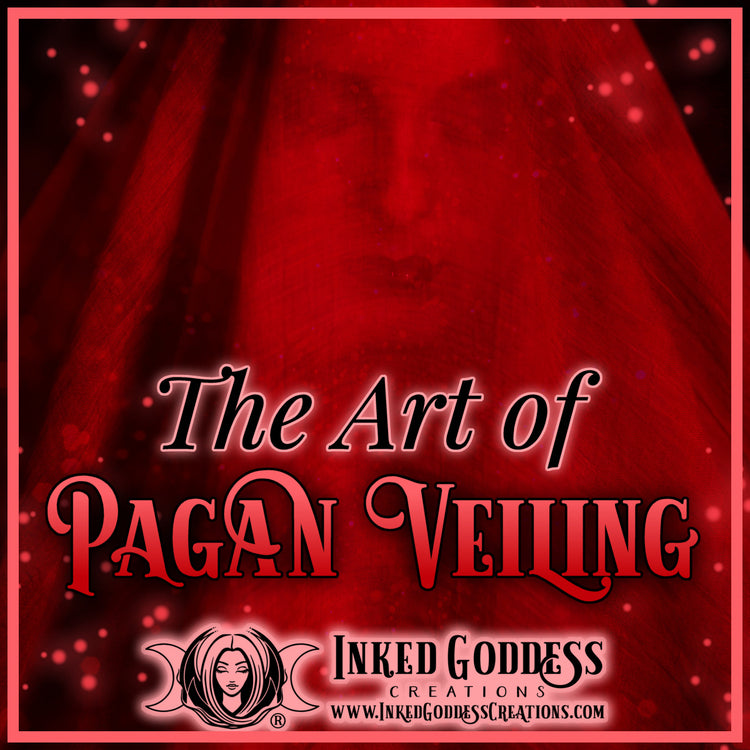The Art of Pagan Veiling

Living a magickal life means you’re exposed to more energies than other people – it’s like we become an antenna for good and bad vibes. It also feels like you’re suddenly on the radar for the spiritual world, so a little extra protection always comes in handy. But this is just one reason you might want to veil in your practice and/or everyday life. Once reserved for Abrahamic religions and specific occasions like funerals or weddings – i.e., a bride’s veil – veiling is becoming popular among the magickal and pagan communities.
Veiled Goddesses
Let’s start with the different goddesses who typically wear a veil or whose devotees may want to wear one. This list isn’t exhaustive, and you may feel the urge to veil when working with your deities, no matter what they wear themselves. This also, of course, includes working with gods.
Hestia
Hestia is the Greek goddess of the fire of the hearth and ritual fire. Her Roman counterpart is Vesta. Hestia is one of the 12 Olympians and the first child of the Titans Cronus and Rhea. She’s the goddess who oversees all sacrifices and is known mainly as the goddess of the home and family hearth. However, her reach also extends to civic hearths, and when the public fire in her temple was neglected, it was a failure of duty to the larger community. She’s graceful, kind, and modest, yet undeniably powerful, and the most beloved goddess of the Olympians themselves.
Hera
Hera is often depicted wearing a veil as the goddess of marriage, women, family, and during childbirth. This goddess is more than just a wife, though. She has incredible powers, including weather manipulation, the ability to shape shift, control minds, and even drive people insane if she’s offended enough.
Demeter
Demeter is the divine mother and goddess of cultivation and crops. You’re probably familiar with her story as it relates to Persephone and Hades, but she’s one of the oldest goddesses of the Mediterranean world. She’s a great magician who offers protection, fertility, healing, and prosperity to her devotees who petition her. She’s sometimes portrayed wearing a veil, which is a beautiful way to honor her when working with her.
Leto
Leto is the mother of Apollo and Artemis and is often referred to as The Obscure One or The Hidden One. She was the primary deity of the Anatolian kingdom, Lykia. This was “Wolf Land,” now modern Turkey, and Leto was known to transform into the shape of a wolf when needed. She protects the realms of death and is worshipped as a goddess of families, mothers, and children.
The Cailleach
The Cailleach is the Celtic goddess of winter. She’s a shapeshifter, though often shown as a crone. Her name actually means the Veiled One. She’s considered the maternal ancestor of all Irish men and is said to have formed Scotland’s mountains, so she’s a pretty big deal. While not evil, she has a complex personality and is wild and potentially destructive, like the winters in Ireland and Scotland can be. Her time is said to be from Samhain through Beltane.
Pagan Veiling
Veiling is an incredibly personal choice. Devotees of these and other deities may choose to veil as a spiritual practice to honor them. At the same time, you may choose to veil without working with deities.
Typically, pagan veiling involves covering the head in some way – either part of the hair or all of it. Some witches veil daily, and others do so only when sitting down to practice their magick or complete a ritual intentionally.
While the idea of veiling may be sensitive – some women feel that it’s a sign of oppression, and in some cases, it has been – the choice to do so is thankfully ours here in the US.
Magickal Veiling
Why would a witch want to veil? There’s something special about being able to wear a specific article of clothing or jewelry when working in a spiritual manner. It offers a tangible symbol of the distinction of how you’re using time. When you wear a veil at your altar, it’s magickal time. When you’re not, then it’s not!
I find it nice to veil when I’m feeling particularly susceptible to the energies around me. So, I’ll add a little protection oil to a scarf or bandana and tie it around my head. This gives my Crown Chakra a little extra protection and reminds me that I am the one who gets to decide who’s welcome in my spiritual bubble and who’s not. I also have a hat adorned with specific items and symbols for protection that I’ll wear when I want to keep on the down low.
So, whether you do it in private or public, veiling can take many forms and is truly a beautiful practice to incorporate into your rituals and life.
